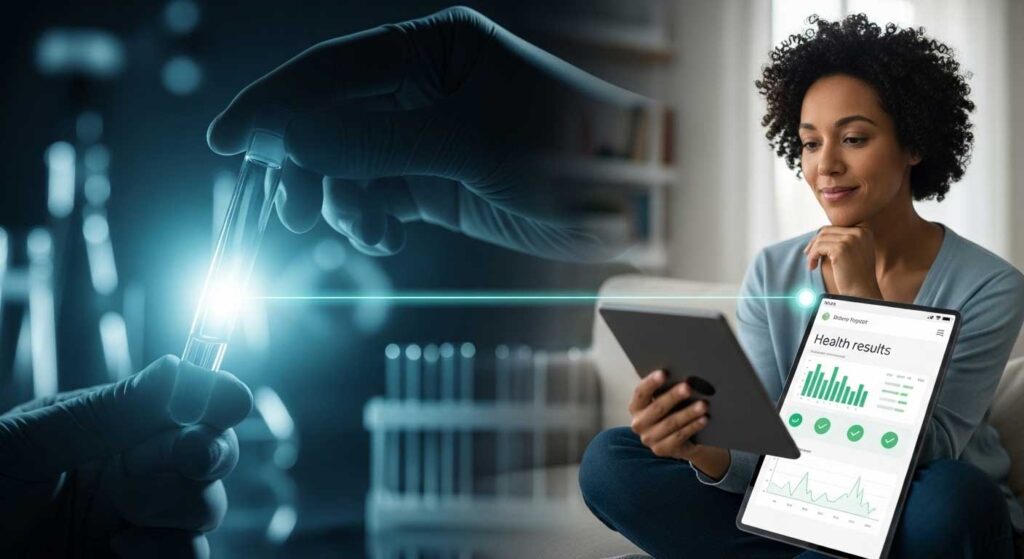Receiving a notification that your lab report is ready can bring a wave of emotions. You open the file, and a screen full of medical acronyms, numbers, and reference ranges stares back at you. For many, this moment is a mix of anxiety and confusion. What do these numbers mean? Can I trust them completely? How accurate are lab results, really?
- The Journey of a Test Result: A Three-Phase Process
- The U.S. Gold Standard: How Professional Labs Guarantee Accuracy
- The Rise of At-Home Testing: Navigating Convenience and Accuracy
- You Are a Key Factor: How to Prevent Inaccurate Results Yourself
- How to Interpret Lab Results: Your Guide to Understanding the Numbers
- Conclusion: Becoming an Empowered Partner in Your Health
- Frequently Asked Questions (FAQ)
This guide is for the proactive U.S. patient who wants to look behind the curtain of medical testing. We’ll explore the entire journey of a test result, from a simple blood draw to the complex world of at-home medical tests. While modern science has made laboratory analysis incredibly precise, the final accuracy of your result is not just a number—it’s the end product of a detailed process involving you, the lab, and your healthcare provider. Understanding this process is the first step toward becoming a truly informed partner in your own health.
The Journey of a Test Result: A Three-Phase Process
To truly grasp how accurate lab results are, it’s essential to understand that a test’s life cycle has three distinct stages. Surprisingly, most errors don’t happen inside the sophisticated machines but in the steps leading up to and following the analysis.
The Pre-Analytical Phase: Where Most Errors Occur
This first phase includes every single step taken before your sample is analyzed. It’s the most vulnerable part of the process and involves everything from patient identification and preparation (like fasting) to the physical collection of the sample, its proper storage, and transportation to the lab.
Shockingly, data shows that up to 75% of all laboratory errors happen during this pre-analytical phase. A simple mistake here, like using the wrong collection tube or storing the sample at an incorrect temperature, can significantly impact the final result long before it reaches a scientist.
The Analytical Phase: The Height of Precision
This is the phase most people picture when they think of a lab test: a vial of blood being processed by a highly calibrated, automated analyzer. Thanks to incredible technology and rigorous quality control, this stage is remarkably accurate.
The analytical error rate in modern certified labs is exceptionally low, often cited as less than 1%. The machines are precise, the methods are validated, and the scientists overseeing the process are highly trained. While no process is perfect, this is the most controlled and reliable part of the journey.
The Post-Analytical Phase: From Data to Diagnosis
Once the machine generates a number, the post-analytical phase begins. This involves correctly recording the data, transmitting the report to your doctor and patient portal, and, most critically, the final interpretation. An error here could be a simple typo in the report or, more complexly, a misinterpretation of the results in the context of your overall health. This final step is where understanding test results moves from raw data to actionable medical insight.

The U.S. Gold Standard: How Professional Labs Guarantee Accuracy
When you get a test done in a hospital or a major third-party lab in the United States, you can be confident in a system built on multiple layers of quality assurance. These aren’t just suggestions; they are stringent federal and industry standards designed to ensure your results are as accurate as possible.
CLIA Certification: The Foundation of Laboratory Quality
The first and most important standard is CLIA (Clinical Laboratory Improvement Amendments). This is a federal certification program overseen by the Centers for Medicare & Medicaid Services (CMS). Essentially, any facility in the U.S. performing lab tests on human samples for health purposes must be a CLIA certified laboratory. This certification ensures the lab meets baseline standards for personnel qualifications, quality control, and testing accuracy.
You can and should verify a lab’s credentials. The U.S. government provides a public database where you can look up any lab’s CLIA status, giving you peace of mind.
CAP Accreditation: The Mark of a Top-Tier Lab
While CLIA is the mandatory foundation, the College of American Pathologists (CAP) accreditation is widely considered the gold standard in the industry. CAP is a voluntary program where labs invite teams of their peers—practicing laboratory scientists and pathologists—to conduct rigorous, on-site inspections.
CAP accredited laboratories often adhere to standards that are even more stringent than federal regulations. Choosing a service that uses CAP accredited laboratories provides an extra layer of confidence that your sample is being handled with the highest possible level of quality and care. When comparing services like Quest Diagnostics vs Labcorp accuracy, it’s reassuring to know that these major labs are not only CLIA certified but also hold this prestigious accreditation.

The Rise of At-Home Testing: Navigating Convenience and Accuracy
The landscape of medical testing is rapidly changing with the growth of at-home medical tests. These kits offer unparalleled convenience, but it’s crucial to understand their differences to gauge their reliability.
Two Main Categories of At-Home Tests
1. Mail-in Kits Processed by a Lab
These kits have become popular for everything from wellness panels to food sensitivity tests. You collect your own sample at home—often a finger-prick blood sample or a saliva swab—and mail it to a laboratory for analysis. The at-home blood test accuracy for these kits is directly tied to the quality of the lab doing the processing. For a reliable result, you must ensure the kit is partnered with a CLIA certified laboratory.

2. Direct-to-Consumer Instant-Read Tests
These are the rapid tests you can buy at a pharmacy, such as those for COVID-19 or the flu. They trade some degree of accuracy for speed and convenience. For example, a rapid influenza test often has high specificity (meaning a positive result is very likely correct) but a much lower sensitivity of only 50-70%. This means it can produce a significant number of false negatives, telling you that you don’t have the flu when you actually do.

The FDA’s Crucial Role in At-Home Testing
For any at-home test, you should always look for evidence of FDA oversight. FDA-approved at-home tests (or those with FDA clearance or Emergency Use Authorization) have been reviewed by the agency to ensure their analytical performance is sound and that the instructions are clear enough for an average person to use correctly.
Bridging the Gap: Convenient and Certified Solutions
For consumers who desire the convenience of at-home collection but demand the accuracy of a professional lab, hybrid services offer an ideal solution. HealthCareOnTime.com, for instance, provides a seamless experience by bridging this gap. You can order a wide range of packages online, from an Essential Wellness Check to an Advanced Cardiac Panel. A professional comes to your home to collect the sample, which is then sent directly to premier CAP accredited laboratories for processing. This innovative model delivers the ultimate combination of convenience and clinical-grade at-home blood test accuracy.
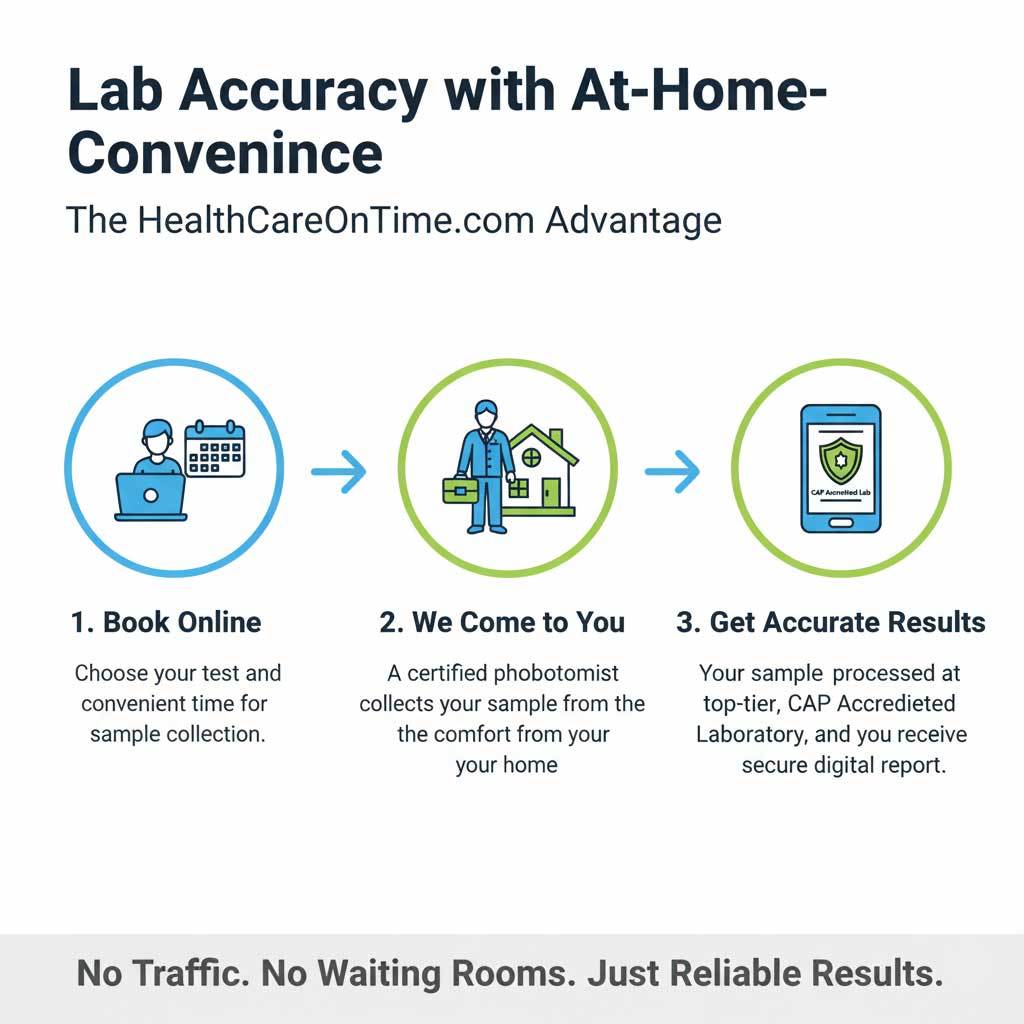
When considering the reliability of at-home thyroid tests, this model is particularly beneficial. While a simple at-home kit might only measure TSH, a comprehensive panel ordered through a service like HealthCareOnTime.com can provide a full, medically relevant picture that is crucial for a proper diagnosis.
You Are a Key Factor: How to Prevent Inaccurate Results Yourself
The final accuracy of a test result doesn’t just depend on the lab; it also depends on you. There are several factors affecting blood test results that are entirely within your control.
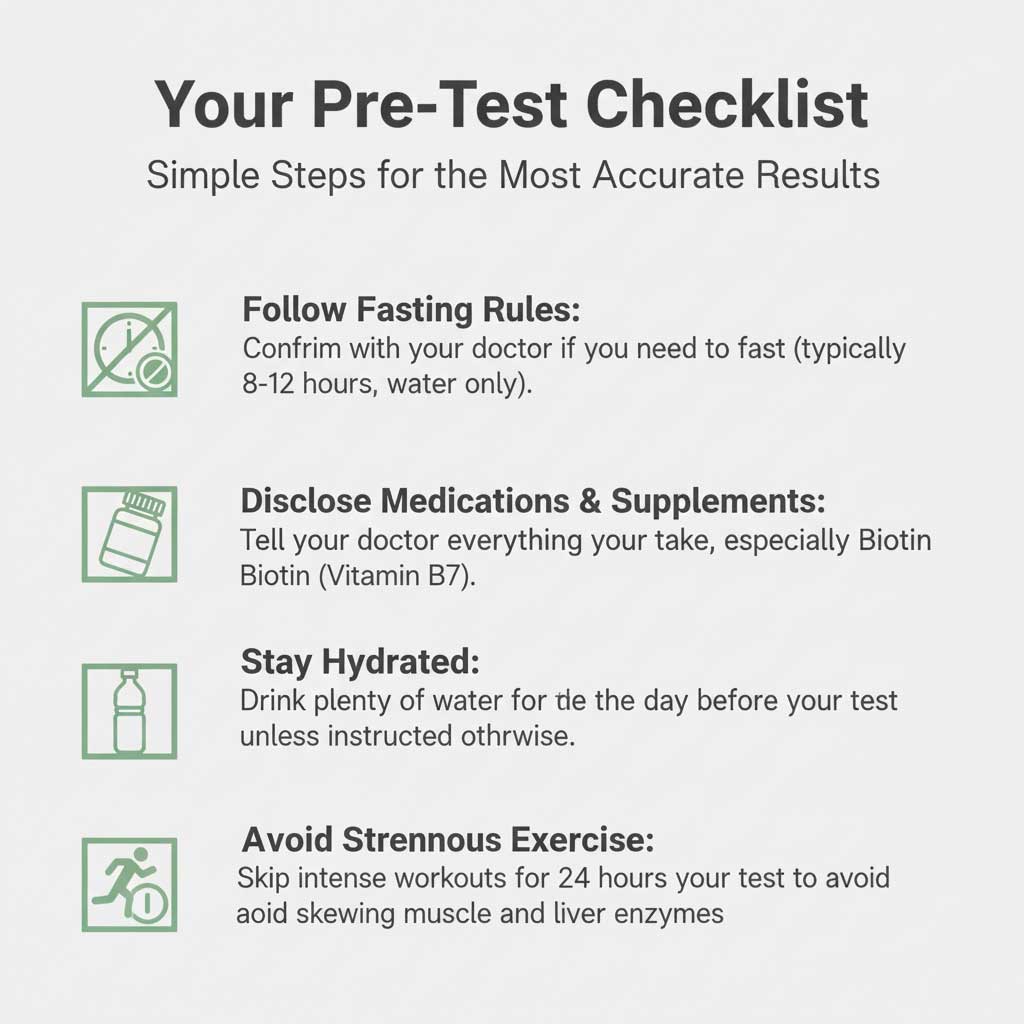
Before You Get Tested
- Follow Fasting Instructions: Fasting is non-negotiable for certain tests, particularly lipid (cholesterol) panels and glucose tests. Eating or drinking anything other than water can temporarily elevate these levels, leading to a falsely high and alarming result.
- Disclose All Medications and Supplements: This is one of the most overlooked yet critical steps. Many substances can interfere with test results. The most notorious example is biotin (Vitamin B7), found in many hair, skin, and nail supplements. The biotin interference with lab tests is well-documented; high doses can cause falsely low results for troponin (a key heart attack marker) and create a completely misleading picture of thyroid function (TSH, T3, T4).
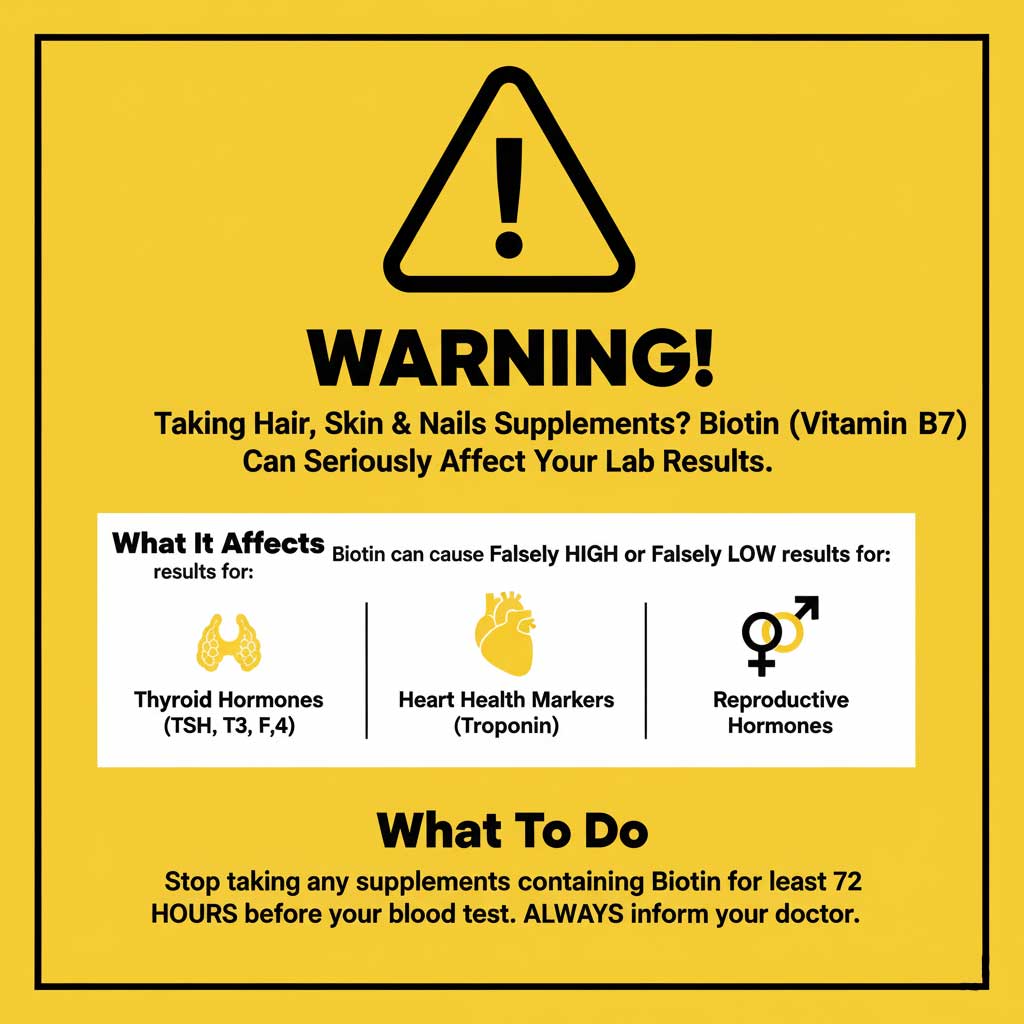
- Manage Lifestyle Factors: Intense exercise right before a blood draw can temporarily increase levels of muscle enzymes like creatine kinase (CK) and even some liver enzymes. Similarly, being dehydrated can concentrate your blood, falsely elevating metrics like red blood cell count and kidney function markers.

For At-Home Sample Collection
If you’re using one of the at-home medical tests, proper collection is paramount. Follow this checklist to ensure the best possible sample quality:

- Read all instructions from start to finish before you begin.
- Thoroughly wash and dry your hands.
- Use only the sterile materials provided in the kit.
- Ensure you collect the required amount of the sample—too little can make analysis impossible.
- Mail your sample back immediately as instructed to prevent degradation.
How to Interpret Lab Results: Your Guide to Understanding the Numbers
Your report has arrived. The next step is understanding test results without falling into the trap of misinformation or unnecessary anxiety.
The “Normal” Range Isn’t an Absolute Truth
The reference ranges listed on your report are a statistical average for a healthy population group. They are not a universal standard. These ranges can vary based on the specific lab, the equipment used, and your age and sex. A result that is slightly outside this range may be perfectly normal for your body. This is a key reason why are my test results different from a previous report or from another lab.
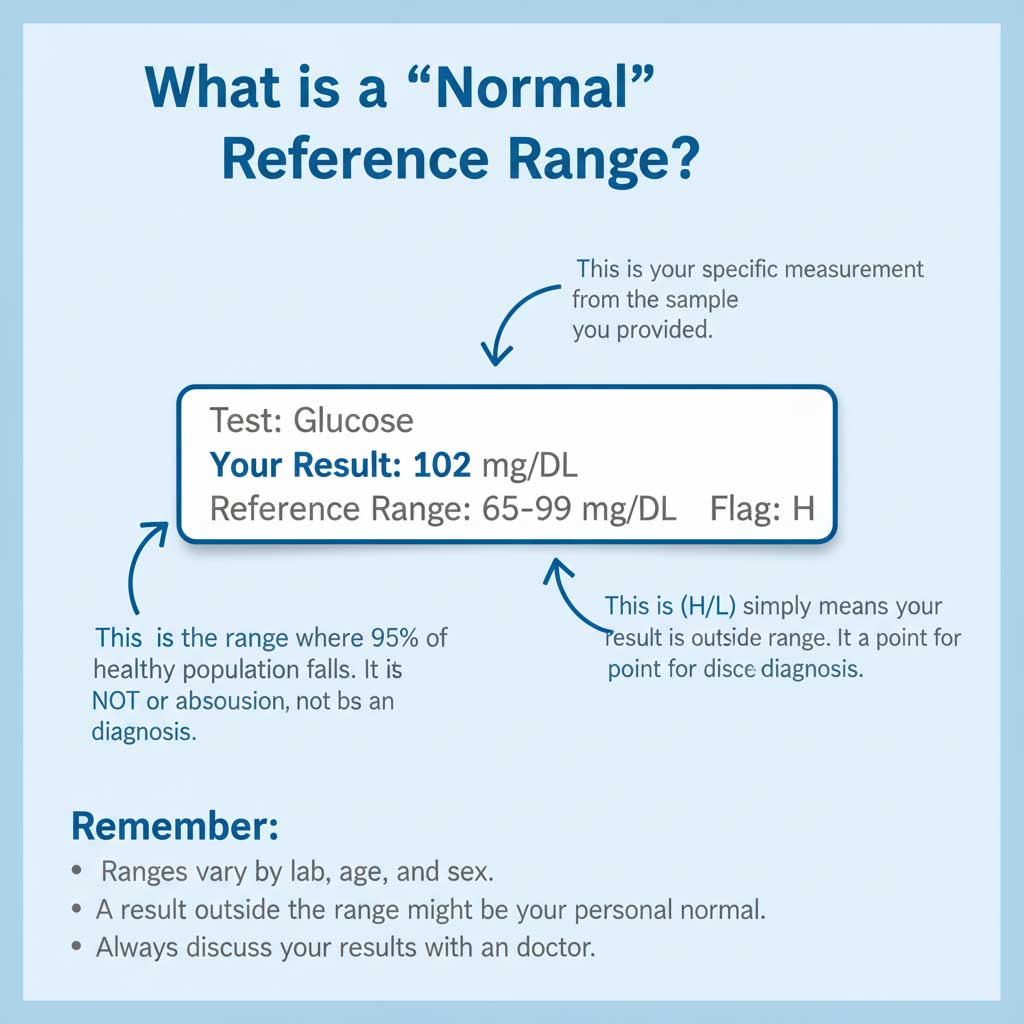
Avoid the Pitfalls of Self-Diagnosis
It is incredibly tempting to plug your abnormal results into a search engine. However, this can lead to immense anxiety over potential false positive test results. A slightly elevated liver enzyme could be due to a medication you took or a strenuous workout, not the dire condition the internet suggests. Understanding test results requires clinical context, which online searches cannot provide.
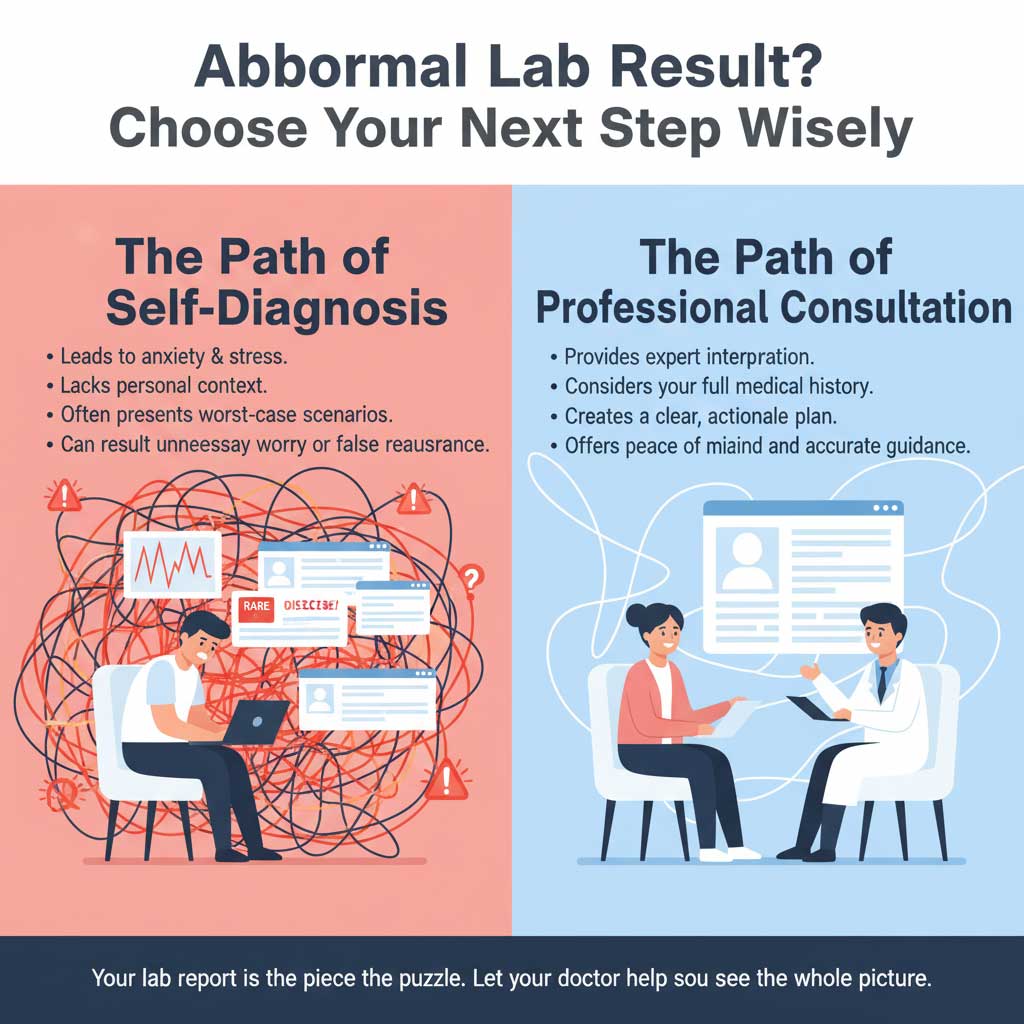
The Irreplaceable Role of Your Doctor
A healthcare professional is trained in how to interpret lab results. They don’t just look at a number in isolation; they synthesize it with your symptoms, your personal and family medical history, a physical exam, and other test results. They understand the nuances of test sensitivity and specificity and can determine whether an abnormal result is clinically significant or just statistical noise. This is why you should always discuss what to do with abnormal lab results with your provider.
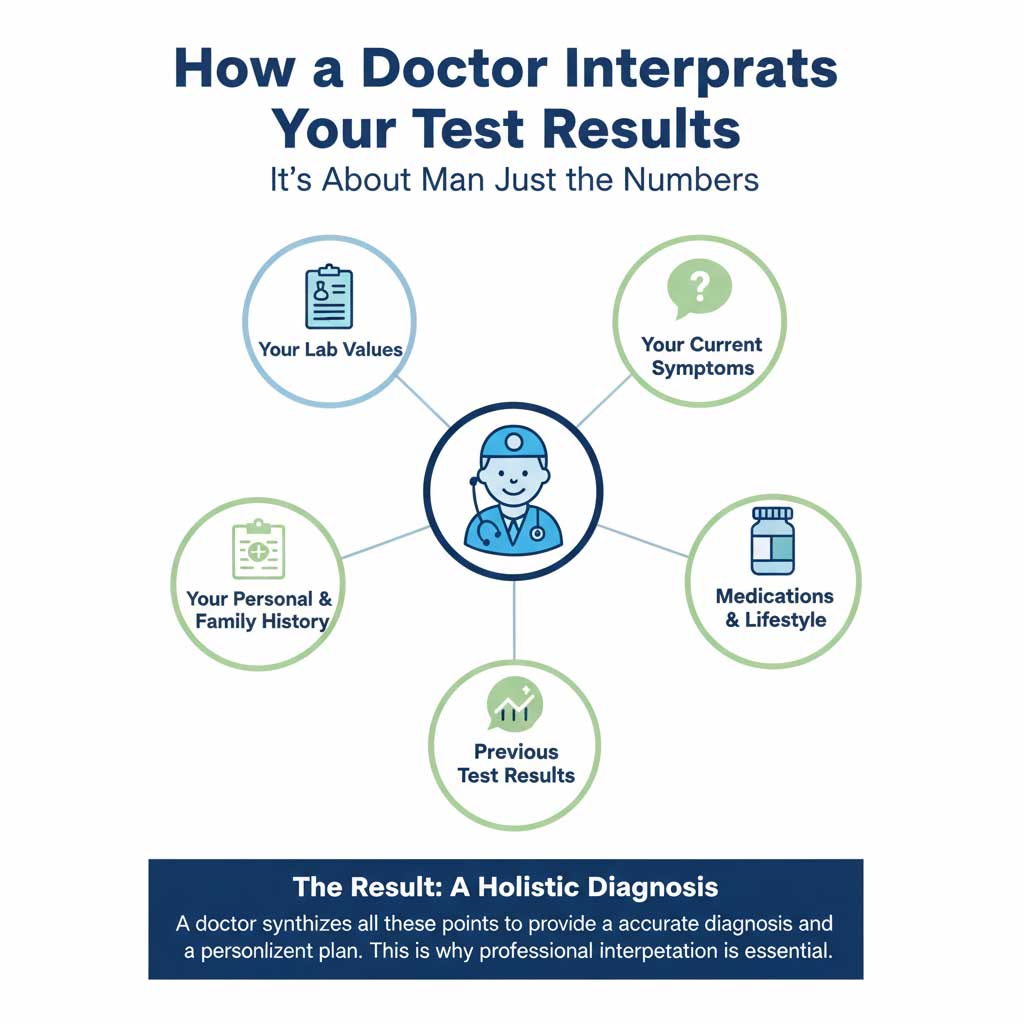
Using Digital Tools to Your Advantage
Modern platforms are making it easier to engage with your health data. When you test through a service like HealthCareOnTime.com, you receive clear, user-friendly digital reports. Their Comprehensive Vitamin Panel, for example, doesn’t just give you a number; it provides medically-vetted context about what each vitamin does. This empowers you to have a more informed and productive conversation with your doctor.
To help you compare your options, here is a detailed breakdown of different testing methods:
| Feature | Professional Lab Draw (e.g., Quest/Hospital) | At-Home Mail-in Kit (Lab-Processed) | At-Home Instant Test (e.g., Rapid Antigen) |
| Accuracy & Reliability | Very High. Controlled environment, professional phlebotomist, processed in CLIA certified / CAP accredited labs. | High to Very High. Accuracy depends heavily on proper user sample collection and the quality of the partner lab (must be CLIA certified). | Variable. Generally lower sensitivity than lab tests. High specificity (a positive is likely a true positive), but risk of false negatives. |
| Regulatory Oversight | High. Governed by CLIA and often accredited by CAP, TJC, or others. | Moderate to High. The processing lab is CLIA-regulated. The kit itself should be FDA-cleared or authorized for consumer use. | Moderate. Test must be FDA-authorized or approved for over-the-counter sale. |
| Best Use Case | Diagnostic testing, complex health evaluations, chronic disease management, and pre-surgical screening. | Health & wellness monitoring, screening for specific conditions, tracking biomarkers over time (e.g., A1c, cholesterol). | Convenient screening for acute infectious diseases (e.g., COVID-19, Flu). Not for diagnosis without confirmation. |
| Cost & Convenience | Can be more expensive and requires travel to a facility. May be covered by insurance. | Often cheaper for uninsured patients. High convenience with at-home collection. | Low cost per test and immediate results. Highest level of convenience. |
| Potential Pitfalls | Inconvenience, scheduling, potential for pre-analytical errors before the sample reaches the lab. | User error in sample collection (most critical factor), sample degradation during shipping, limited scope of testing. | High rate of false negatives, results can be influenced by user error, not suitable for complex diagnostics. |
Conclusion: Becoming an Empowered Partner in Your Health
The accuracy of your medical test results is a shared responsibility. The lab provides the analytical precision, you provide the properly prepared and collected sample, and your doctor provides the crucial clinical interpretation. By understanding test results and the entire process behind them, you transform from a passive recipient of data into an active, empowered participant in your healthcare.
Be proactive. Ask your doctor questions. Always disclose your medications and supplements. Choose testing services that partner with high-quality, certified labs. Use your results not as a final diagnosis, but as a valuable starting point for a meaningful conversation with the healthcare professional you trust.
Ready to take the next step in your health journey with confidence? Explore the testing packages at HealthCareOnTime.com to access convenient at-home sample collection that is professionally processed by top-tier, CAP accredited laboratories.

